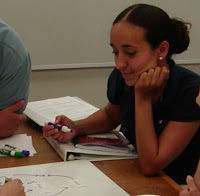 |
| December is a time to reflect. |
Photograph by Shän Boggs.
It has been an amazing year
of great blog interviews – from Mark Kirkpatrick with his wonderful mountain
home designs to Debbie Arnold a multi-talented artist of stunning nature
paintings; dancer Luo Yi preserving ancient Chinese dance to Jim Masterson
with his amazing gift for healing horses; Matt Haugland and his fascinating
work with microclimates to storm chaser and tornado researcher Robin
Tanamachi; Ford Roosevelt with his educational scholarships to at risk kids
through Project GRAD LA to Aaron Gentry Boggs who volunteered to work with
refugees in Uganda, teaching art and computer classes; Lidewij Niezink on the
importance of empathy and creating a culture of kindness to Howard Glasser
and his significant work with ADHD children; educational pioneer, researcher
and author Dr. Franklin CampbellJones on his work in Cultural Proficiency to
science educator Arthur Beauchamp and his new science curriculum that uses
tabloids to teach students about “critical thinking”; the amazing artist and
writer Linda Vallejo with her stunning art and comments on creativity to new
writer David Hall, a former street kid nurtured by a group of concerned adults
that helped raise him to adulthood; Exploratorium Director Dennis Bartel on
his amazing experiential museum in San Francisco to Dr. Jeffrey Basara and
his climate research and special interest in flash drought.
|
When I started this blog, a
friend asked me why I wasn’t journaling and providing reports on my thoughts
and activities. Well… I’ve been so fortunate to have been introduced to or
know so many interesting people doing interesting things that I really wanted
to write about them. The response to my requests for interviews has been
wonderful.
Throughout the blogs, I was
left with a sense that many of the people I interviewed held a deep feeling
of gratitude for others that had helped nurture their talents along the way -
people who saw something in them or rallied round them to accomplish great
things. Whether it was a parent, mentor, friend or an entire team of people –
few worked in isolation to accomplish their goals or dreams. There was a form
of guidance or a support system of like-minded people that set them on a course to success.
So it is with me, I am
happy to share. I have had an amazing year, with the publication of three
cookbooks for people with food sensitivities – the Fast and Fabulous
Gourmet Cookbook series – Mediterranean,
Pacific Rim and Diet editions. Old friends came to my aid to guide me
and provide me with the advice I needed. And new friends came into my life
with amazing skills and abilities.
|
e-Book designs created by Jim Bunte.
Photographs by Geoffrey Nelson.
Anyone who knows me is aware
that I have struggled for years with food allergies and that I became very ill
a few years ago. Happily, I was able to change my diet and improve my health
significantly by returning to a Mediterranean diet. It is my hope that these
e-cookbooks will also help others seeking healthy and delicious food.
My gratitude goes out to
Suzanne Tripier, who taught me how to cook when I lived with her family
overseas in Mallorca, Spain; Dr. Carmen Arriola, who shared with me the link
between diet and my illness; Naomi Renbarger for her edits and recommendations;
writer/editor Jim Hollander for his wonderful Foreword; photographer Geoffrey
Nelson, who I knew in Mallorca (and reconnected with here in California) and
took the beautiful food photographs for all three books; Wei Wong for her inspiring book cover designs; and last, but not
least, Jim Bunte an extraordinary e-book designer and web designer, who shared
in the vision of what these cookbooks could be and took them to a higher level.
As December winds down, may
you take joy in reflecting on all that you have accomplished this year and may
you have a Wonderful New Year full of exciting opportunities. ~ Shän Boggs
Cover designs by Wei Wong.
Photographs by Geoffrey Nelson.
Shän Boggs is a writer and
editor living in California. Her interests include science, technology, the environment, health, education,
multimedia, art, and gourmet cooking.
10/29/25
At present, the cookbooks are offline for updates. And I am working on some new and exciting projects.
Thank you for visiting Interesting People. It just celebrated over 32,000 views on this day!







































